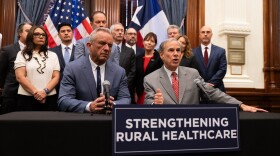-
Kansas received the sixth-highest amount among the states at $221 million.
-
Texas is set to receive the largest award from the federal Rural Health Transformation Program — with federal officials awarding $1.4 billion to the state over five years. The state received millions more in funding that it asked for in its application.
-
Texas' application for the Rural Health Transformation program requests $200 million every year of the five-year program. The state is proposing the "Rural Texas Strong" project, which includes a range of proposals to improve health care access and quality in rural areas — such as workforce development and utilizing AI.
-
Alongside the passage of billions of dollars in Medicaid spending reductions over a decade, Oklahoma is also vying for an opportunity available to all 50 states to fund sustainable rural health care initiatives.
-
As Texas develops its application for federal Rural Health Transformation Program funding, rural hospital leaders say stabilizing their facilities should be a top priority. "Without it, all the planning in the world will not matter because there will be no hospital left to transform," one said.
-
Texas health officials are asking for public input for the state's application for a new federal rural health program. People can submit their comments through Tuesday, Sept. 9.
-
The Health and Human Services secretary praised recent health legislation out of Texas during a visit with Gov. Greg Abbott.
-
The $50 billion rural health fund established in President Donald Trump's megabill seeks to help stabilize and strengthen rural hospitals and providers.
-
Oklahoma health care leaders estimate state hospitals will see $6.3 billion in Medicaid reimbursement cuts as funding reductions made to the program through President Donald Trump's "One Big Beautiful Bill" set in.
-
Republican U.S. Sen. Jerry Moran of Kansas said he made changes to the Senate’s version of the Trump administration's reconciliation bill to soften the blow of Medicaid cuts on Kansas hospitals. But health care advocates say it won’t be enough.

Play Live Radio
Next Up:
0:00
0:00
Available On Air Stations









